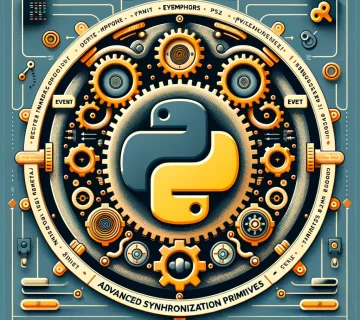Python is renowned for its simplicity and flexibility, making it an ideal language for both beginners and seasoned developers. Among its core features, numeric data types hold a significant place, enabling programmers to perform a myriad of mathematical, scientific, and engineering calculations. This guide will explore two primary numeric data types in Python: integers and floats, shedding light on their characteristics, uses, and common pitfalls.
Integers (int)
In Python, integers (int) represent whole numbers, positive or negative, without decimals. They are often used in Python to iterate over loops, perform arithmetic operations, and manage data in sequences or collections.
Key Characteristics and Uses:
- Unlimited Length: Python integers can grow to an unlimited size (limited only by available memory), unlike in some languages where integer size is constrained by the system.
- Arithmetic Operations: You can perform all standard arithmetic operations with integers, including addition, subtraction, multiplication, division, and modulo.
- Loop Counting: Integers are commonly used as counters in loops. For example,
for i in range(10):iterates ten times using integer values from 0 to 9. - Indexing and Slicing: Integers serve as indexes and slices in lists, tuples, and strings, allowing access to specific elements or sections.
Common Mistakes:
- Division Confusion: When dividing integers, using
/results in a float, while//gives the quotient as an integer, potentially confusing newcomers. For instance,5 / 2yields2.5, whereas5 // 2results in2. - Mutable Default Arguments: Using integers as default arguments in function definitions can lead to unexpected behavior if not handled correctly.
# Defining an integer
x = 10 # 'x' is an integer with a value of 10
# Changing the value of an integer
x = 15 # Now 'x' has a new value of 15
# Performing arithmetic operations
y = x + 5 # Addition: 'y' will be 20
z = x - 5 # Subtraction: 'z' will be 10
a = x * 2 # Multiplication: 'a' will be 30
b = x / 2 # Division: 'b' will be 7.5, note that this results in a float
c = x // 2 # Integer division: 'c' will be 7, dropping any decimal part
d = x % 3 # Modulo operation: 'd' will be 0, which is the remainder of x divided by 3
# Using integers for loop control
for i in range(5): # Iterates 5 times with 'i' taking values from 0 to 4
print(i)
# Indexing with integers
my_list = [10, 20, 30, 40, 50]
first_item = my_list[0] # Indexing lists with integers, 'first_item' will be 10
# Defining integer with binary, octal, and hexadecimal notation
binary_int = 0b1010 # Binary representation, equals to 10 in decimal
octal_int = 0o12 # Octal representation, equals to 10 in decimal
hex_int = 0xA # Hexadecimal representation, equals to 10 in decimal
# Using integers in a function
def add_five(num):
return num + 5 # Adds 5 to the input integer and returns the result
result = add_five(x) # Calling the function with 'x' (value 15), 'result' will be 20
Floating-Point Numbers (float)
Floating-point numbers (float) represent real numbers and can include fractions or decimals. They are crucial for precision-based calculations, such as scientific measurements or financial computations.
Key Characteristics and Uses:
- Precision and Representation: Floats in Python can represent very large or very small numbers, but they are not always 100% accurate due to the nature of binary representation of decimals. This is a common issue in many programming languages, not just Python.
- Scientific Notation: Floats can be expressed in scientific notation, which is useful for very large or small numbers, e.g.,
1.5e2represents150.0. - Arithmetic Operations: Like integers, floats support all standard arithmetic operations. Mixed operations with integers result in floats.
- Functionality in Libraries: Floats are widely used in Python libraries for data analysis, machine learning, and scientific computing, such as NumPy and Pandas, for precise and complex calculations.
Common Mistakes:
- Floating-Point Arithmetic: Due to their precision issue, comparing floats directly can lead to unexpected results. It’s recommended to use a threshold for equality checks.
- Mixing Types in Operations: Mixing floats and integers in operations can sometimes lead to confusion about the result type, especially for beginners.
Practical Examples and Tips:
- Converting Between
intandfloat: You can convert between integers and floats usingint()andfloat()functions respectively. This is particularly useful when you need precise control over the data type in calculations or data processing.
- Mathematical Functions: Python’s
mathmodule provides a vast array of mathematical functions and constants that work with floats, enhancing the functionality for complex calculations. - Decimal Module: For financial applications where precision is crucial, consider using the
decimalmodule, which provides support for fast correctly-rounded decimal floating-point arithmetic.
# Converting an integer to a string
x = 10
x_str = str(x) # Converts 'x' to a string, 'x_str' will be "10"
num_int = int(5.8) # Results in 5
num_float = float(5) # Results in 5.0
# Concatenating an integer with a string (requires conversion)
message = "The value of x is " + str(x) # 'str(x)' converts 'x' to a string for concatenation
# Formatting strings with integers
formatted_message = f"The value of x is {x}" # Using f-string for clean and readable string formatting
# Using integers in string multiplication
repeat_str = "ha" * x # Repeats the string "ha" 10 times because x is 10
# Padding numbers with zeros (useful for dates, IDs, etc.)
padded_number = str(x).zfill(5) # 'padded_number' will be "00010", padding 'x' value with zeros up to 5 characters
# Using 'format()' method with integers for more complex formatting
price = 123
formatted_price = "The price is ${:,.2f}".format(price) # Formats 'price' as a float with 2 decimal places and commas
# String indexing and slicing using integers
my_string = "Hello, World!"
first_char = my_string[0] # 'first_char' will be 'H', indexing starts at 0
substring = my_string[0:5] # 'substring' will be "Hello", slicing from index 0 to 4
# Using integer with 'len()' function to get the length of a string
string_length = len(my_string) # 'string_length' will be 13, the number of characters in "Hello, World!"
# Converting a string number to an integer
num_str = "20"
num_int = int(num_str) # Converts 'num_str' to an integer, 'num_int' will be 20
# Using integers for iterating through characters in a string with a loop
for i in range(len(my_string)): # Iterates over each index of 'my_string'
print(my_string[i]) # Prints each character in 'my_string' one by one
Conclusion
Understanding the intricacies of integers and floats is fundamental to mastering Python programming. These data types are indispensable for a wide range of programming tasks, from simple arithmetic to complex scientific calculations. By grasping their characteristics, uses, and common pitfalls, developers can write more efficient, accurate, and reliable code.





No comment